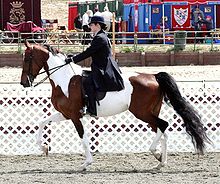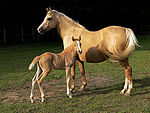- National Show Horse
-
National Show Horse 
Distinguishing features high-set, swan-like neck without a pronounced crest; small, refined head, small ears; straight or concave profile; very deep, laid back shoulder; high tail carriage Alternative names NSH Country of origin United States Breed standards The National Show Horse Registry Breed standards The Arabian Horse Association Breed standards Horse (Equus ferus caballus) The National Show Horse, (NSH), originated as a cross between an American Saddlebred and an Arabian horse. It is now established as a separate breed, since the founding of a breed registry in August 1981.[1] Registered animals today may be the offspring of registered NSH parents or may be a combination between an American Saddlebred, Arabian, and a National Show Horse. Non-NSH mares and stallions must be registered with their appropriate registries, and stallions who are Arabian or Saddlebred must additionally be nominated and approved by the NSHR board of directors. Although any combination of these three breeds may be used, as of December 1, 2009 there must be at least 50% Arabian blood in the horse to be registered, up to 99% Arabian blood (formerly 25% minimum Arabian blood was required for registry).[1][2]
Contents
Breed characteristics
The horses combine the refinement of the Arabian with the animation of the Saddlebred. The resulting horse has the high-set, upright, long, swan-like neck of the Saddlebred. The neck should not have a pronounced crest. The head is usually refined and small, with small ears and either a straight or concave profile. The horses are close-coupled with a level topline and have a very deep, laid back shoulder. The tail carriage is high.[1] Typically, the NSH is 14.3-16.2 hands tall, with some individuals over or under.
The NSH may be a variety of colors, including the traditional bay, gray, chestnut, and black of the Arabian, with Saddlebred ancestry adding a broader range of color than seen in the Arabian breed, including, most notably, pinto and palomino.
Uses
The breed is usually used for saddle seat riding. They are horses with high-stepping action and can be trained to move with a very elevated front end. Some can be trained to be five-gaited, adding the slow gait and rack to the traditional gaits of the walk, trot and canter. A versatile breed, they can also be used for show jumping, endurance, dressage, or western riding.[1]
Notes
References
- Dutson, Judith Storey's Illustrated Guide to 96 Horse Breeds of North America North Adams, Mass.: Storey Pub 2005 ISBN 1-58017-612-7
- NSHR Press Release Is Your Horse Now Eligible for NSH Registration?
External links
Equine Equine science and
management
Equestrianism
and sportGlossary of equestrian terms · List of Equestrian Sports · Horse tack · Bit · Bridle · Saddle · Harness · English riding · Western riding · Driving · Horse training · Horse racing · Equestrian at the Summer Olympics (medalists, venues) · Horse show · EquitationEvolution and history Domestication · In warfare · In the Middle Ages · Horses in East Asian warfare · History of the horse in South Asia · Horses in the Napoleonic Wars · Horses in World War I · Horses in World War II · History of the horse in BritainHorse breeds, types
and other EquidaeList of horse breeds · Wild horse · Feral horse · Stock horse · Gaited horse · Draft horse · Warmblood · Sport horse · List of horse breeds in DAD-ISOther EquusHybridsCategories:- Horse breeds
- Arabian and part-Arabian horses
- Horse breeds originating in the United States
Wikimedia Foundation. 2010.
